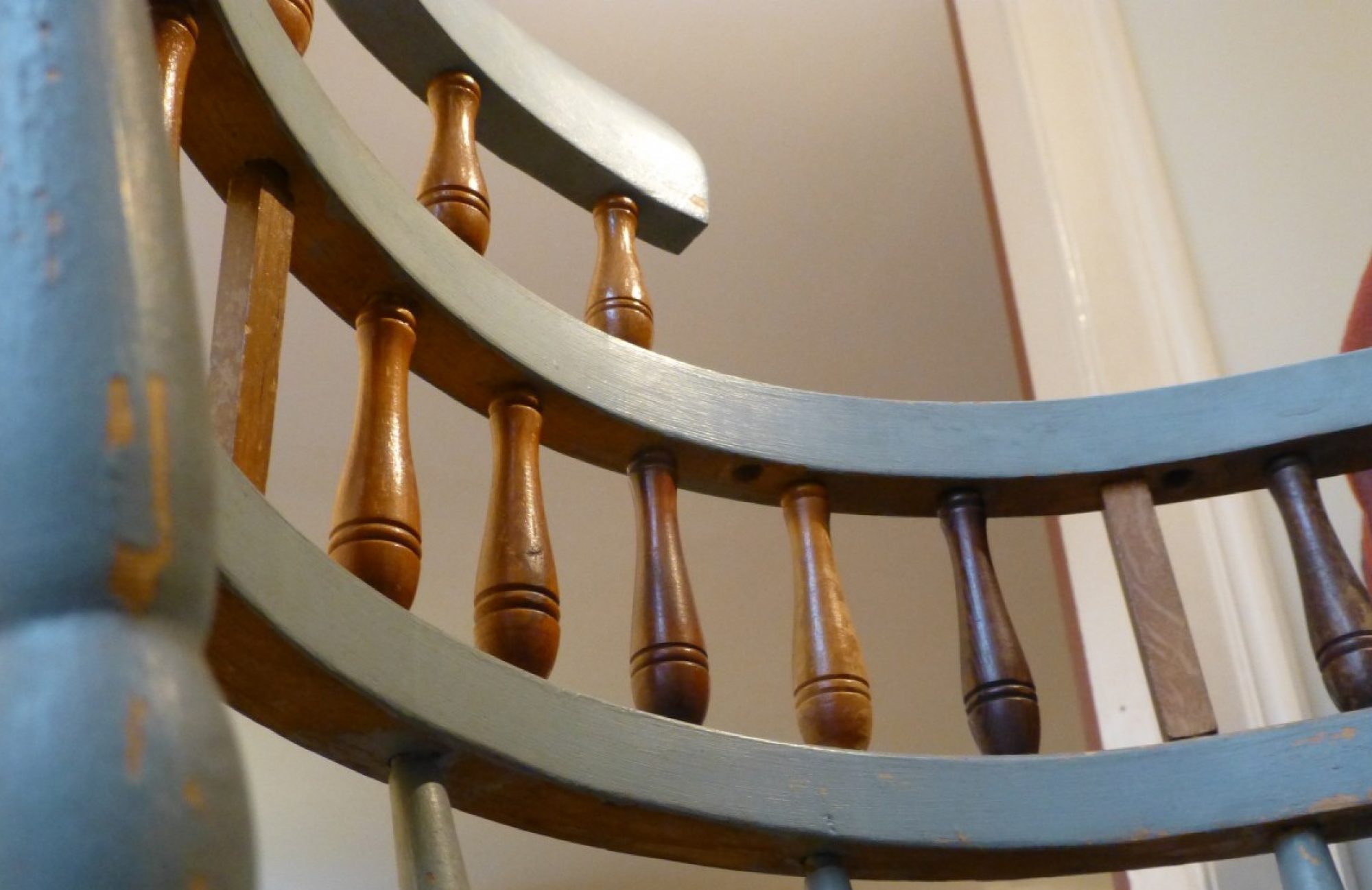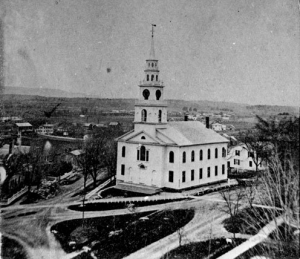
The Middlebury Congregational Church is a valued landmark of Middlebury, VT and has been around for over 200 years.(1) However, the people of Middlebury didn’t always have a permanent place of worship. On September 5, 1790, the Church of Christ in Middlebury was created by a solemn covenant signed by five women and seven men. The church adopted the Covenant, the Confession of Faith, and the Articles of Discipline common to other Congregational churches in the New England area.(2) As an organization, the church needed deacons or ordained ministers of the church. Although Mr. Hale and Mr. Sumner acted as deacons up until 1798, the official deacons that held office after the completion of the church in 1809 were Deacon Seth Storrs and Deacon Ebenezer Sumner. They served until their deaths in 1837 and 1844 respectively. A third deacon, Joseph Kirby, was also elected in 1809 and held office until his death in 1831.(3)
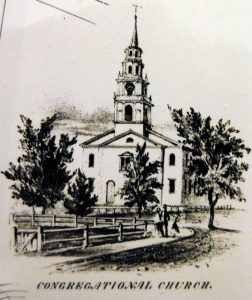
From 1790, up until the construction of the Congregational Church structure, the people of Middlebury acted only as a congregation and had worshipped in barns and taverns. A permanent location was desperately needed. In 1794, Gamaliel Painter, agent of the project, selected a site at the head of main street. Construction of the church began in 1806 and was entirely financed by local volunteer donors rather than through taxation.(4) The church spanned a height of 135 feet and included a five-tiered spire, a flexible frame that could withstand strong winds (such as the 1938 and 1950 hurricanes), and ionic column supports. There was also a bell installed in 1821 and then replaced in 1841, as well as a clock which was installed in 1853. The most recent interior renovation occurred in 2001.(5) The building, designed by Lavius Fillmore, was completed in 1809 and ended up costing only $9,000.(6)
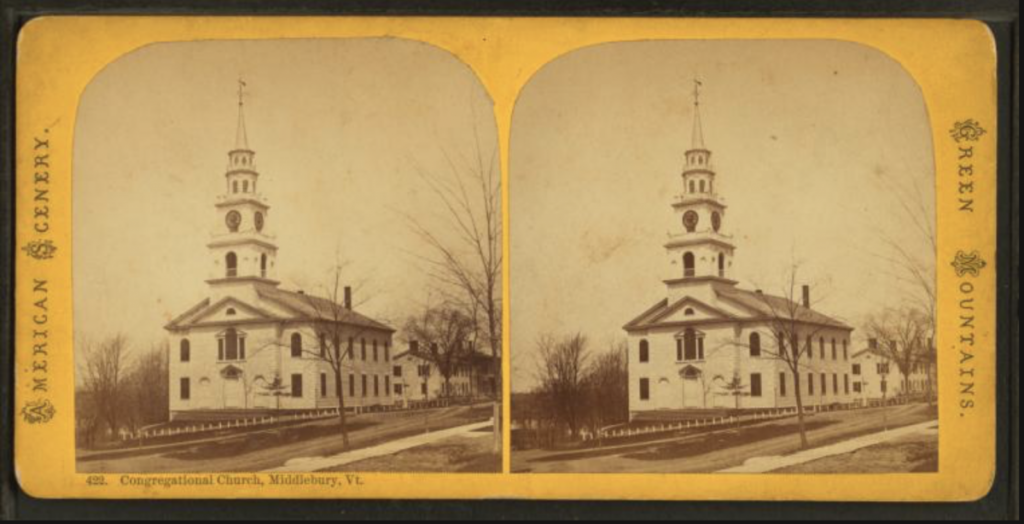
Lavius Fillmore was an early nineteenth century architect in Vermont, also known for designing the first church in Bennington in 1806 and the Monroe House at South Shaftsbury. Fillmore took a unique approach to the Middlebury church design, modeling the tower for the edifice after Joseph Brown’s First Baptist Church in Providence, which was itself inspired by a design completed by architect James Gibbs.(7) Within a couple years of the church’s completion, these “Gibbsian” towers became high fashion in New England. Fillmore’s architectural style led to local businesses advertising larger scale windows, fine hardware, and a variety of paints. Average houses even began displaying elegant doorways, fan windows, and luxurious fireplaces.(8) Fillmore passed away in 1850, having lived in Vermont since 1805. Over the course of his life he took interest in real estate, milling, and bookselling, and he maintained a respected reputation throughout his career.(9)
Since 1809, the church has been very active, reaching its highest membership of 781 people in 1836. Although more members allowed for better representation of the church, more voices also led to different views on how the church should be run. The Manual, published in 1853 and republished multiple times since then, gave a text of 25 standing rules and articles related to religious discipline contributing to the resolution of this issue.(10)
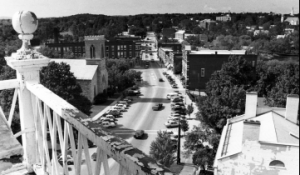
Fortunately, the Middlebury Congregational Church is still standing and operational. The church has nearly 300 members and remains socially active in worship and community service. Aside from being a valued structure in the Middlebury community, the church is also a part of the United Church of Christ (UCC).(11) The UCC is only present in the United States with almost one million total members and over 5,000 churches. In the United States, most of the Congregational Christian Churches joined with the Evangelical and Reformed Churches to form the UCC in 1957.(12) Since the early 21st century, the UCC has supported civil rights, abortion rights, sex education and same-sex marriage. This is not at all surprising as the UCC has supported anti-slavery, missionary movements, and progressive social action since its creation.(13) A prime example of the UCC’s involvement in education occurred on December 31, 1824, when the Middlebury Congregational Church established “Bible Classes” for the children of the church between the ages of 12 and 18 once every month.(14)
Circling back to Henry Sheldon’s chair, the spindle was made using timber cut from the flat east of Court Street by Mr. Abril Chalen. The wood specimen was taken from the section of the main spine after being removed to make room for the Town Clock.(15) The first town clock was placed on trial in 1852 at the annual village meeting, where the people voted a tax of eight cents to pay for its addition. The total cost of the clock came out to be $281.40 including cost of labor, fixtures, and the cast iron material. It remained in use for 39 years and was replaced in 1891.(16)
– Lubomir Cuba ’19
Footnotes:
1 Stephen A. Freeman and Glenn Andres, “Church History – The Congregational Church, UCC, Middlebury, Vermont,” midducc.org/history/
2 Stephen A. Freeman, The Congregational Church of Middlebury, VT 1790-1990. Middlebury Congregational Church, 1990.
3 Ibid.
4 Glenn M. Andres, “Architectural elegance: Lavius Fillmore’s Refinement of the New England Meeting House,” The Walloomsack Review 2 (October 2009).
5 Freeman and Glenn, “Church History – The Congregational Church, UCC, Middlebury, Vermont,” midducc.org/history/
6 Ibid.
7 Glenn M. Andres, “Architectural elegance: Lavius Fillmore’s Refinement of the New England Meeting House,” The Walloomsack Review 2 (October 2009).
8 Ibid.
9 Ibid.
10 Stephen A. Freeman, The Congregational Church of Middlebury, VT 1790-1990. Middlebury Congregational Church, 1990.
11 “Who We Are: Open and Affirming Congregation | The Congregational Church, UCC, Middlebury, Vermont,” midducc.org/who-we-are/
12 Donald K. McKim, “Christianity: United Church of Christ.” Worldmark Encyclopedia of Religious Practices, edited by Thomas Riggs, 2nd ed., vol. 1: Religions and Denominations, Gale, 2015, 355-363.
13 McKim, “Christianity: United Church of Christ,” 355-363.
14 Stephen A. Freeman, The Congregational Church of Middlebury, VT 1790-1990. Middlebury CongregationalChurch, 1990.
15 HL Sheldon Papers, Vol 19, Collection of the Henry Sheldom Museum, Middlebury, Vermont
16 Ibid.
